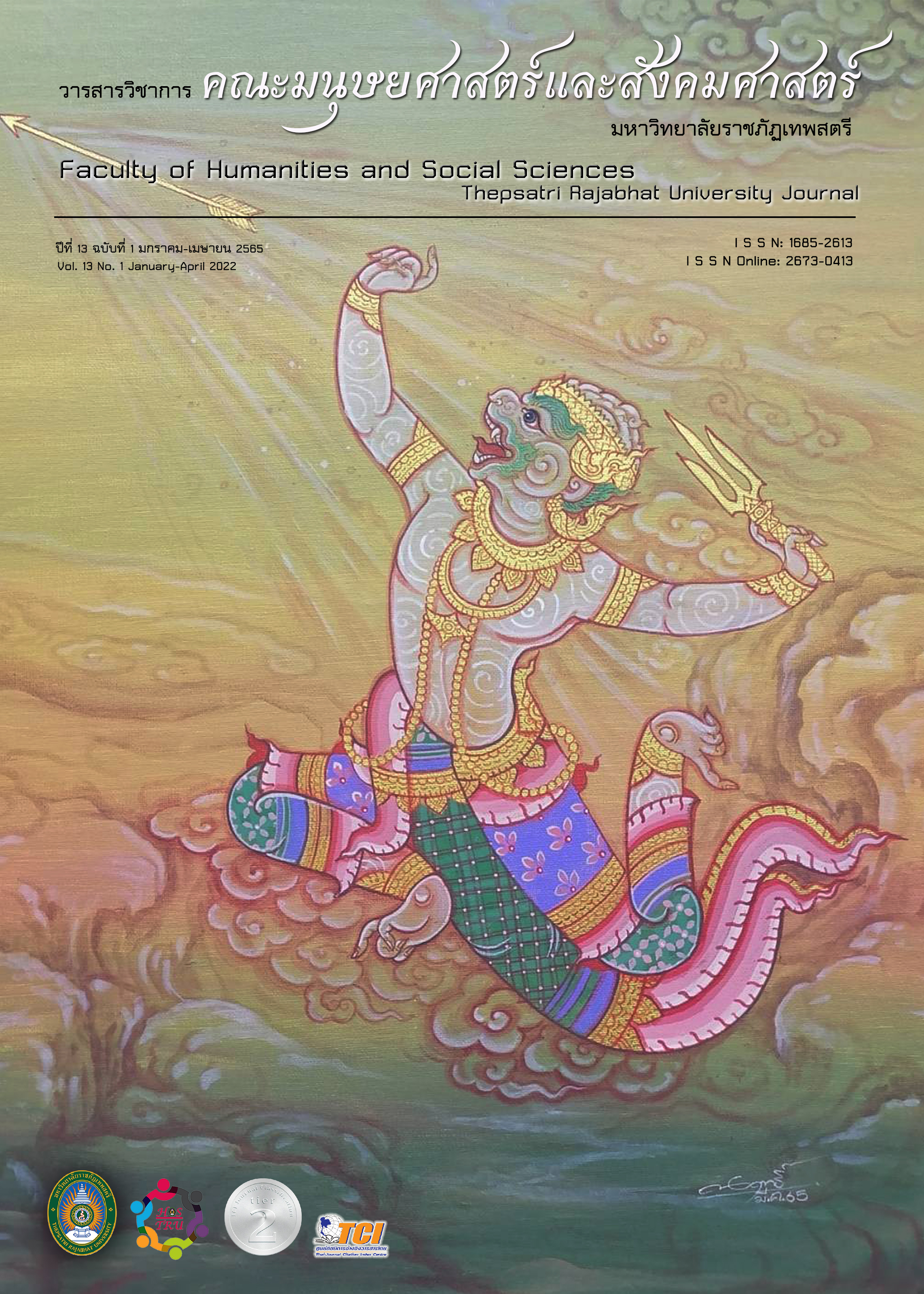The Development of Geographical Skills in the Course of SS 2203401 Geographic Information System and Maps with STEM Education Arrangement for the 4th year Students in Social Science Program at Thepsatri Rajabhat University
Main Article Content
Abstract
The objectives of this research were 1. to compare the geographical skills of students who learned with the STEM educational method and the geographical skills of students who learned with the traditional learning method; 2. to compare learning achievement before and after the learning with the STEM educational method; and 3. to study on the students’ satisfaction from learning with the STEM education method in the course of SS 2203401 Geographic Information System and Maps. The samples of the study included 28 students in the 4th-year study of Social Science Program in the 1st semester of 2020 academic year at Faculty of Humanities and Social Sciences, Thepsatri Rajabhat University in Lopburi Province. The purposive sampling was used, and the research instruments were lesson plans for learning activity arrangement according to STEM education, a measurement scale of geographical skills, a test of learning achievement, and a measurement scale of learning satisfaction. The data were analyzed into percentage, means, standard deviation, and t-test. The research results revealed that 1. the students who learned with the STEM educational method gained higher geographical skills than the students who learned with the traditional learning method with the statistical significance of .05; 2. the students who learned with the STEM educational method had learning achievement in the posttest higher than their learning achievement in the pre-test with the statistical significance of .05; and 3. the students were satisfied with the STEM educational method in the course of SS 2203401 Geographic Information System and Maps in overall of the 3 aspects at the ‘most’ level ( = 4.61, S.D. = 0.54)
Downloads
Article Details

This work is licensed under a Creative Commons Attribution-NonCommercial-NoDerivatives 4.0 International License.
The content and information presented in articles published in the Academic Journal of the Faculty of Humanities and Social Sciences, Thepsatri Rajabhat University, are solely the opinions and responsibilities of the respective authors. The editorial board of the journal neither necessarily agrees with nor assumes any responsibility for such content in any manner whatsoever.
All articles, information, content, and images published in the Academic Journal of the Faculty of Humanities and Social Sciences, Thepsatri Rajabhat University, are the copyright of the journal. Any person or organization wishing to reproduce, disseminate, or otherwise utilize all or any part thereof must obtain prior permission from the Academic Journal of the Faculty of Humanities and Social Sciences, Thepsatri Rajabhat University.
References
กระทรวงศึกษาธิการ. (2560). หลักสูตรแกนกลางการศึกษาขั้นพื้นฐาน พุทธศักราช 2551 (ฉบับปรับปรุงพุทธศักราช 2560). กรุงเทพฯ: คุรุสภาลาดพร้าว.
ชนัฎดา ภูโปร่ง. (2560). การจัดการเรียนรู้แบบสะเต็มศึกษา STEM Education เพื่อส่งเสริมทักษะความคิดสร้างสรรค์และเจตคติต่อวิชาวิทยาศาสตร์ ของนักเรียนระดับชั้นมัธยมศึกษาปีที่ 2 ในชั้นเรียนวิทยาศาสตร์. วิทยานิพนธ์ปริญญาหาบัณฑิต มหาวิทยาลัยมหาสารคาม.
ชิดชนก วันทวี. (2557). การพัฒนาทักษะการคิดวิเคราะห์และทักษะทางภูมิศาสตร์ของนักเรียนชั้นมัธยมศึกษาปี ที่ 1 ด้วยวิธีสอนแบบโครงงาน. วิทยานิพนธ์ปริญญามหาบัณฑิต มหาวิทยาลัยเทคโนโลยีราชมงคลธัญบุรี.
นงนุช เอกตระกูล. (2558). การพัฒนาการจัดการเรียนรู้ แบบ STEM เพื่อเพิ่มผลสัมฤทธิ์ทางการเรียนและความสามารถในการคิดแก้ปัญหาอย่างสร้างสรรค์ (CPS) ของนักเรียนชั้นประถมศึกษาปีที่ 6. กรุงเทพฯ: โรงเรียนอัสสัมชัญธนบุรี.
บุญชม ศรีสะอาด. (2556). วิธีการทางสถิติสำหรับการวิจัย เล่ม 1 (พิมพ์ครั้งที่ 5). กรุงทพฯ: สุวีริยาสาส์น.
ปิยะบุตร ถิ่นถา, ชรินทร์ มั่งคั่ง, และเชษฐภูมิ วรรณไพศาล. (2560, กันยายน-ธันวาคม). การจัดการเรียนรู้วิชาภูมิศาสตร์ โดยใช้สะเต็มศึกษาเพื่อพัฒนาทักษะการคิดแก้ปัญหาของนักเรียนชั้นมัธยมศึกษาปีที่ 4 โรงเรียนสาธิตเทศบาลบ้านเชตวัน. Veridian E-Journal, Silpakorn University ฉบับภาษาไทย สาขามนุษยศาสตร์ สังคมศาสตร์ และศิลปะ, 10(3), 819-835.
ปนัดดา พาณิชยพันธุ์. (2561). รายงานผลการดำเนินการ มคอ. 5 รายวิชา สศ 2203401 ระบบสารสนเทศภูมิศาสตร์และแผนที่ สาขาวิชาสังคมศึกษา คณะมนุษยศาสตร์และสังคมศาสตร์. ลพบุรี: มหาวิทยาลัยราชภัฎเทพสตรี.
ไปรยาลภัส สหพัฒนสมบัติ. (2562). ผลการจัดการเรียนรู้ตามแนวสะเต็มศึกษาเพื่อส่งเสริมความสามารถในการแก้ปัญหาเรื่อง เศรษฐกิจพอเพียงกับการพัฒนาประเทศกลุ่มสาระการเรียนรู้สังคมศึกษา ศาสนาและวัฒนธรรมของนักเรียนชั้นมัธยมศึกษาปีที่ 3. วิทยานิพนธ์ปริญญามหาบัณฑิต มหาวิทยาลัยบูรพา.
พิมพา นวลสวรรค์. (2557). การสร้างแผนกิจกรรมเสริมความรู้และทักษะทางภูมิศาสตร์โดยเน้นผู้เรียนเป็นสำคัญสำหรับผู้เรียนช่วงชั้นที่ 3. วิทยานิพนธ์ปริญญามหาบัณฑิต มหาวิทยาลัยเชียงใหม่.
ศูนย์สะเต็มศึกษาแห่งชาติ. (2557). สะเต็มศึกษาประเทศไทย. สืบค้น มีนาคม 20, 2564 จาก http://www.stemedthailand.org/wp-content/uploads/2015/03/newIntro-to-STEM.pdf.
สมศักดิ์ ภู่วิภาดาวรรธน์. (2554). การยึดผู้เรียนเป็นศูนย์กลางและการประเมินตามสภาพจริง. เชียงใหม่: โรงพิมพ์แสงศิลป์.
สำนักวิชาการและมาตรฐานการศึกษา. (2560). ตัวชี้วัดและสาระการเรียนรู้แกนกลาง สาระภูมิศาสตร์ (ฉบับปรับปรุง พ.ศ. 2560). กรุงเทพฯ: คุรุสภาลาดพร้าว.
อภิสิทธิ์ ธงไชย. (2556, พฤศจิกายน-ธันวาคม). เทคโนโลยีและวิศวกรรมคืออะไรในสะเต็มศึกษา. สถาบันส่งเสริมการสอนวิทยาศาสตร์และเทคโนโลยี (สสวท.), 42(185), 35-37.


